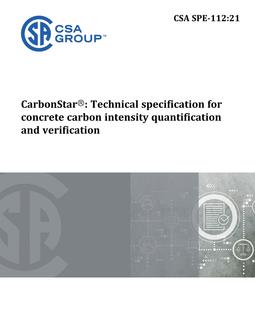Click here to purchase
Preface:
This is the first edition of CSA SPE-112, CarbonStar®: Technical specification for concrete carbon intensity quantification and verification. This Document, written under Standards Council of Canada’s National Technical Specification Guidelines, has been developed without using the full consensus process.
CSA Group acknowledges that the development of this Technical Specification was made possible, in part, by the financial support of the Standards Council of Canada.
Scope:
1.1 General
This Technical Specification provides minimum requirements and recommendations for the quantification and verification of the carbon intensity in a unit of concrete, including any carbon that is permanently sequestered during the production of the concrete and/or its input materials. Therefore, this number could be either positive or negative.
The quantification calculation results in a CarbonStar® rating expressing:
a) the carbon intensity of concrete in kilograms (pounds) of CO2 and/or CO2e per cubic metre (cubic yard), subject to the methodology in this Technical Specification; and
b) where applicable, the net CO2 sequestered in kilograms (pounds) per cubic metre (cubic yard), or as otherwise required for the purposes of carbon credits, offsets, or tax incentives.
Note: This Technical Specification provides a methodology for quantifying carbon emissions and sequestration for a declared unit of 1 m3 (yd3) of concrete. When selecting concrete options for a given application, functional criteria, including strength, constructability, performance, and durability, also need to be considered.
For example, in Canada, CSA A23.1 provides performance and durability requirements for ready-mixed concrete, CSA A23.4 covers these same requirements for precast concrete, and CSA A23.3 covers structural requirements; and for specific types of structures, CSA S6 covers bridge construction and CSA S413 covers parking structures. In the USA, ACI 318 covers structural and durability requirements for buildings, ACI 350.5 covers environmental structures, and ACI 562 covers concrete repairs.
1.2 Terminology
In this Technical Specification, “shall” is used to express a requirement, i.e., a provision that the user is obliged to satisfy in order to comply with the Technical Specification; “should” is used to express a recommendation or that which is advised but not required; and “may” is used to express an option or that which is permissible within the limits of the Technical Specification. Notes accompanying clauses do not include requirements or alternative requirements; the purpose of a note accompanying a clause is to separate from the text explanatory or informative material. Notes to tables and figures are considered part of the table or figure and may be written as requirements. Annexes are designated normative (mandatory) or informative (non-mandatory) to define their application.
Product Details
- Edition:
- 1st
- Published:
- 04/01/2021
- ISBN(s):
- 9781488334252
- Number of Pages:
- 39
- File Size:
- 1 file , 2 MB
- Product Code(s):
- 2428823, 2428823
